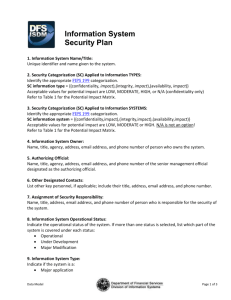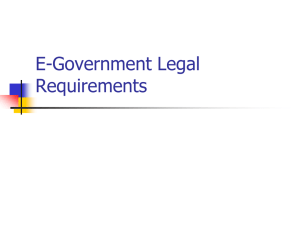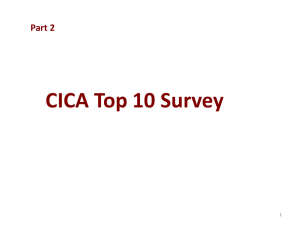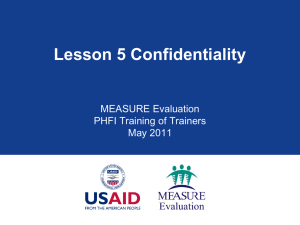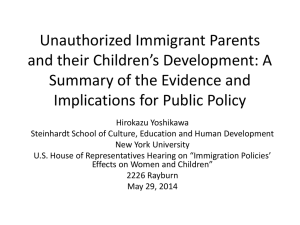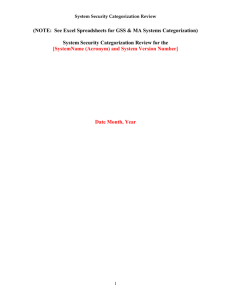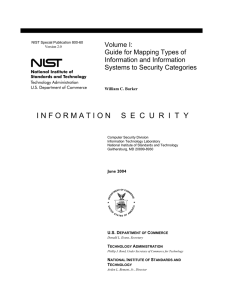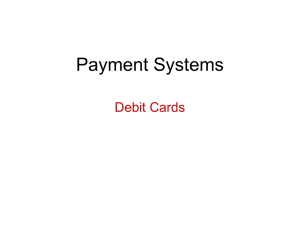Guide for Mapping Types of Information and Information Systems to
advertisement
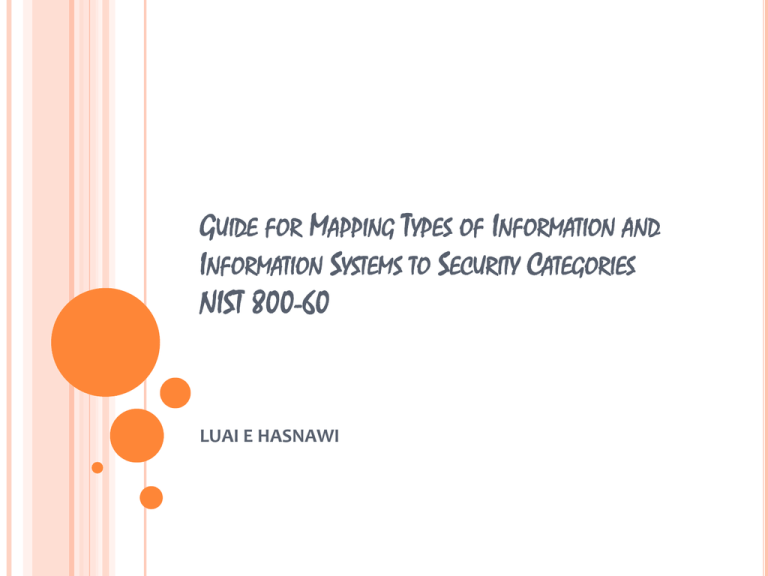
GUIDE FOR MAPPING TYPES OF INFORMATION AND
INFORMATION SYSTEMS TO SECURITY CATEGORIES
NIST 800-60
LUAI E HASNAWI
IMPORTANT NOTICE
This
paper does not include any national
security guidelines.
This guideline has been developed to
assist Federal government agencies to
categorize information and information
systems.
GUIDELINES OBJECTIVES
The guideline’s objective is to facilitate provision of
appropriate levels of information security according to
a range of levels of impact or consequences that
might result from the unauthorized disclosure,
modification, or loss of availability of the information
or information system.
OUTLINES
Security Categorization of information and
information system.
Assignment of impact levels and security
categorization
Guidelines for assignment of impact levels to missionbase information
Impact level by type for management and support.
SECURITY IMPACT LEVELS
INFORMATION TYPE
Mission-based info.
•Agency’s mission-specific activities
Management and support info.
•Administrative, management and
support
This guideline addresses mission-based
information separately from the more agencycommon
management
and
support
information. Because the consequences of
security
compromise
of
mission-based
information vary among different operational
environments, this guideline is less prescriptive
in the case of mission-based information than in
the case of management and support
information.
SECURITY OBJECTIVES AND TYPE OF POTENTIAL LOSSES
Security
Objectives
Confidentiality
Integrity
Availability
IMPACT ASSESSMENT
Security Category information type = {(confidentiality, impact), (integrity, impact), (availability, impact)}
MAPPING INFORMATION TYPE TO SECURITY CONTROLS AND IMPACT
LEVEL
Security categorization process.
Identify information systems
Identify information types.
Select provisional impact levels.
Review and adjust provisional
impact levels.
Assign system security category
HOW TO IDENTIFY INFORMATION TYPE
HOW TO IDENTIFY INFORMATION TYPE - 2
CATEGORIZATION OF FEDERAL INFORMATION AND INFORMATION SYSTEM
LOW
MODERATE
HIGH
Confidentiality
Preserving authorized
restrictions on
information access and
disclosure.
The unauthorized
disclosure of information
could be expected to have
a limited adverse effect on
organizational operations,
organizational assets, or
individuals.
The unauthorized disclosure
of information could be
expected to have a serious
adverse effect on
organizational operations,
organizational assets, or
individuals.
The unauthorized disclosure
of information could be
expected to havea severe or
catastrophic adverse effect
on organizational
operations, organizational
assets, or individuals.
Integrity
Guarding against
improper information
modification or
destruction, and includes
ensuring information nonrepudiation and
authenticity.
The unauthorized
modification or
destruction of information
could be expected to have
a limited adverse effect
on organizational
operations, organizational
assets, or individuals.
The unauthorized
modification or
destruction of information
could be expected to have
a serious adverse effect
on organizational
operations, organizational
assets, or individuals.
The unauthorized
modification or destruction
of information could be
expected to have a severe or
catastrophic adverse effect
on organizational
operations, organizational
assets, or individuals.
Availability
Ensuring timely and
reliable access to and use
of information.
The disruption of access
to or use of information
or an information system
could be expected to have
a limited adverse effect
on organizational
operations, organizational
assets, or individuals.
The disruption of access
to or use of information
or an information system
could be expected to have
a serious adverse effect
on organizational
operations, organizational
assets, or individuals.
The disruption of access
to or use of information
or an information system
could be expected to have
a severe or catastrophic
adverse effect on
organizational
operations, organizational
EXAMPLE
An organization managing public information on its web
server determines that there is no potential impact from a
loss of confidentiality (i.e., confidentiality requirements are
not applicable), a moderate potential impact from a loss of
integrity, and a moderate potential impact from a loss of
availability. The resulting security category of this information
type is expressed as:
Security Category public information = {(confidentiality, n/a), (integrity, moderate), (availability, moderate)}
OTHER FACTORS FOR SELECTION OF IMPACTS LEVELS
2 IMPORTANT FACTS ABOUT INFORMATION IMPACT LEVEL
1.
The impact of compromise of information of a
particular type can be different in different agencies
or in different operational contexts.
2.
The impact for an information type may vary
throughout the life cycle
ADDITIONAL FACTORS FOR SYSTEM CATEGORIZATION
Aggregation
Some information may have little or no sensitivity in
isolation but may be highly sensitive in aggregate
Critical System Functionality
Compromise of some information types may have low
impact in the context of a system’s primary function but
may have much more significance when viewed in the
context of the potential impact of compromising:
Other systems to which the system in question is connected, or
Other systems that are dependent on that system’s information.
INFORMATION TYPE
Mission-based info.
•Agency’s mission-specific activities
Management and support info.
•Administrative, management and
support
GUIDELINES FOR ASSIGNMENT OF IMPACT LEVELS TO
MISSION-BASED INFORMATION
Mission-based information includes both mission
information and information associated with the
mechanisms that the government uses to achieve its
missions.
Mission-based information types are, by
definition, specific to individual departments and
agencies or to specific sets of departments and
agencies.
IDENTIFICATION OF MISSION-BASED INFORMATION TYPES
The first step in mapping types of Federal information and
information systems is the development of an information taxonomy,
or creation of a catalog of information types.
Example of two steps process
Begin by documenting
the agency’s business
and mission areas
Define the major
sub-function that
are necessary to
the conduct of
each business.
IMPACT ASSESSMENT FOR MISSION-BASED INFORMATION
the entity responsible for impact determination must
assign impact levels and consequent security
categorization for each mission-based information
type identified for each system. The final system
security categorization is based on the impact levels
for each information type stored in, processed by, or
generated by the system.
Management and
support lines of
business and
information types
Service delivery
support
information
Government
resource
management
information
1. Service delivery support information
1.1. Control and oversight
1.1.1. Corrective action
The confidentiality, integrity and availability impact levels are based on the effects of unauthorized
disclosure, modification, or loss of availability of corrective
action information on the ability of
responsible agencies to remedy internal or
external programs that have been found noncompliant with a given law, regulation, or policy.
1.1.2. Program evaluation
The confidentiality, integrity and availability impact levels are based on the effects of unauthorized
disclosure, modification, or loss of availability of program evaluation information on the abilities of
responsible agencies to analyze internal and external program effectiveness and to determine appropriate
corrective actions.
1.1.3. Program monitoring
The impact levels are based on the effects of unauthorized disclosure, modification, or loss of availability
of program monitoring information on the ability of responsible agencies to perform data-gathering
activities
1. Service delivery support information
1.2. Regulatory Development
1.2.1. Policy and guidance development
the ability of responsible agencies to create and disseminate guidelines to assist in the interpretation and
implementation of regulations
1.2.2. Public comment tracking
the ability of responsible agencies to solicit, maintain, and respond to public comments regarding
proposed regulations
1.2.3. Regulatory creation
the ability of responsible agencies to research and draft proposed and final regulations.
1.2.4. Rule publication
the ability of responsible agencies to publish proposed or final rules in the Federal Register and Code of
Federal Regulations
1. Service delivery support information
1.3. Planning and resource allocation
1.3.1. Budget formulation
the ability of responsible agencies to determine priorities for future spending and to develop an itemized forecast
of future funding and expenditures during a targeted period of time.
1.3.2. Capital planning
the ability of responsible agencies to ensure that appropriate investments are selected for capital expenditures.
1.3.3. Enterprise architecture
the ability of responsible agencies to describe the current state and define the target state and transition strategy
for an organization’s people, processes, and technology.
1.3.4. Strategic Planning
the ability of responsible agencies to determine long-term goals and to identify of the best approach for achieving
those goals.
1.3.5. Budget execution
the ability of responsible agencies to manage day-to-day requisitions and obligations for agency
expenditures, invoices, billing dispute resolution, reconciliation, service level agreements, and
distributions of shared expenses.
1.3.6. Workforce planning
the ability of responsible agencies to identify workforce competencies required to meet the agency’s
strategic goals and for developing the strategies to meet these requirements.
1.3.7. Management improvement
the ability of responsible agencies to gauge the ongoing efficiency of business processes and identify
opportunities for reengineering or restructuring.
1. Service delivery support information
1.4. Internal Risk management and Mitigation
1.4.1. Contingency Planning
the ability of responsible agencies to plan for, respond to, and mitigate damaging events.
1.4.2. Continuity of Operation
the ability of responsible agencies to identify critical systems and processes, and to conduct the planning
and preparation required to ensure that these systems and processes will be available in the event of a
catastrophic event.
1.4.3. Service Recovery
the ability of responsible agencies to develop plans for resuming operations after a catastrophe occurs,
such as a fire or earthquake.
1. Service delivery support information
1.5. Public Affairs
1.5.1. Customer service
the ability of responsible agencies to provide and manage the delivery of information and support to the
government’s customers.
1.5.2. Official Information Dissemination
the ability of responsible agencies to provide official Federal government information to external
stakeholders through the use of various communications media.
1.5.3. Product outreach
the ability of responsible agencies to market government services products, and programs to the general
public in an attempt to promote awareness and increase the number of customers/beneficiaries of those
services and programs.
1.5.4. Public Relation
the ability of responsible agencies to promote an organization’s image through the effective handling of
citizen concerns.
1. Service delivery support information
1.6. Revenue Collection
1.6.1. Debt collection
the ability of responsible agencies to properly and efficiently collect money owed to the United States
government from both foreign and domestic sources.
1.6.2. User fee collection
the ability of responsible agencies to correctly and efficiently enforce, regulate, and effect the collection
of fees assessed on individuals or organizations for the provision of Government services and for the use
of Government goods or resources.
1.6.3. Federal asset sales
the ability of responsible agencies to properly and efficiently acquire, oversee, track, and sell noninternal assets managed by the Federal government with a commercial value and sold to the private
sector.
1. Service delivery support information
1.7.Legislative Relation
1.7.1. Legislation tracking
the ability of responsible agencies to follow legislation from conception to adoption.
1.7.2. Legislation testimony
the ability of responsible agencies to provide testimony/evidence in support or, or opposition to,
legislation from conception to adoption.
1.7.3. Proposal Development
the ability of responsible agencies to draft proposed legislation that creates or amends laws subject to
Congressional legislative action
1.7.4. Congressional Liaison
the ability of responsible agencies to support their formal relationships with the U.S. Congress.
1. Service delivery support information
1.8. General government
1.8.1. Central fiscal operation
may affect the security of the critical banking and finance infrastructure. The potential for consequent
loss of human life or of major national assets is typically low.
1.8.2. legislative functions
the ability of responsible agencies to provide service support activities associated with costs of the
Legislative Branch other than the Tax Court, the Library of Congress, and the Government Printing
Office revolving fund.
1.8.3. Executive function
Depends on the executive information type on functions of the Executive Office
1.8.4. Central property management
the ability of the General Services Administration to acquire, provide, and centrally administer offices
buildings, fleets, machinery, and other capital assets and consumable supplies used by the Federal
government.
1.8.5. central personnel management
the ability of the Office of Personnel Management to build a high quality and diverse Federal workforce,
based on merit system principles.
1.8.6. Taxation Management
the ability of designated agencies to enforce the Internal Revenue Code and to collect taxes in the United
States and abroad.
1. Service delivery support information
1.8. General government
1.8.7. Central records and statistics management
the ability of responsible agencies to manage official documents, statistics, and records for the entire
Federal government.
1.8.8. Income information
the ability of the Federal government to identify citizen entitlements and obligations and to protect
individuals against identity theft and the Federal government against fraud.
1.8.9. Personal identity and authentication
the ability of Federal agencies to determine that communications with and payments to individuals are
being made with or to the correct individuals.
1.8.10. Entitlement event
the ability of the Federal government to establish qualifications of individuals to receive government
benefits
1.8.11. Representative Payee
the ability of the Federal government to determine that entitlement funds are being used appropriately for
the well-being of entitled individuals.
2. Government Resource
2.1. Human resources management
2.1.1. Benefits management
2.1.2. Personnel management
2.1.3. Personnel management & expense
reimbursement
2.1.4. Resource training & development
2.1.5. Security clearance management
2.1.6. Staff recruitment and employment
2. Government Resource
2.2. Administrative management
2.2.1. Facilities, fleet & equipment management
2.2.2. Help desk service
2.2.3. Security management
2.2.4. Travel Information
2.2.5. Workplace policy development and
management
2. Government Resource
2.3. Information and technology management
2.3.1. System development
2.3.2. Lifecycle/change management
2.3.3. System maintenance
2.3.4. IT infrastructure management
2.3.5. IT security
2.3.6. Record retention
2.3.7 Information management
2. Government Resource
2.4. Financial management
2.4.1. Assets and liability management
2.4.2. Reporting and information
2.4.3. Budget and finance
2.4.4. Accounting
2.4.5. Payments
2.4.6. Collections and receivable
2. Government Resource
2.5. Supply Chain management
2.5.1. Goods acquisition
2.5.2. Inventory Control
2.5.3. Logistics management
2.5.4. Service acquisition
